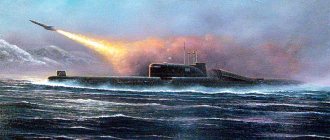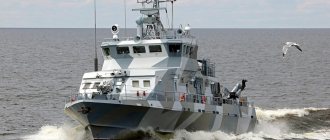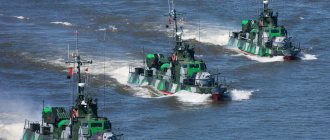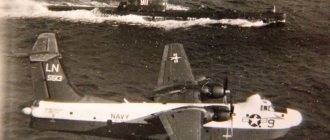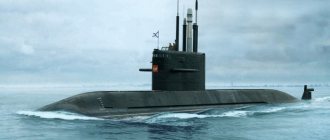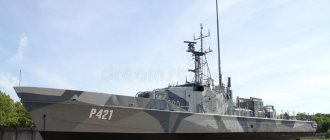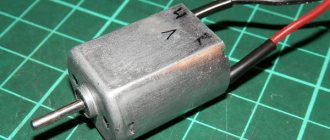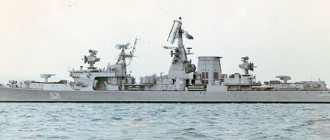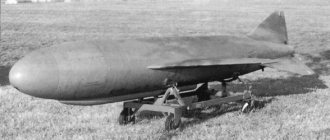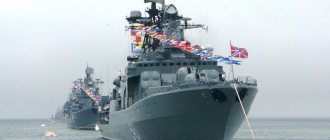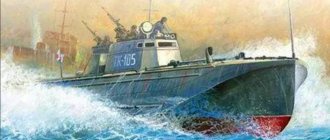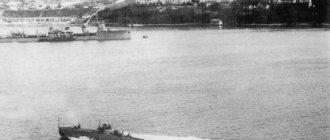Small torpedo ships part 2
- Published: 02/18/2014, 21:02
- Seal
Contents of the material
- Small torpedo ships part 2
- All pages
Page 1 of 41
SMALL TORPEDO SHIPS The section was created on the basis of the book “Torpedo or” (under the general editorship of A.E. Taras) and other materials.
Part 2
Part 1
Chapter 5 Torpedo boats of the Second World War
NEW TORPEDO WEAPON Torpedoes from the 40s. were even more advanced than the pre-war ones. During the war years, the speed of steam-gas torpedoes reached 50-55 knots; and their range increased to 15-20 km. At the same time, the destructive effect of torpedo weapons increased, which now carried an extremely powerful explosive charge (by the end of the war, up to 500-600 kg of TNT equivalent). To equip torpedoes, along with TNT, they began to use substances with a stronger susceptibility to detonation: tetryl, hexogen and others. Finally, the number of travel modes has increased: many wartime torpedoes had three range and speed modes; the Italians even managed to create six-mode samples. The increase in speed and range occurred while maintaining the same caliber. Therefore, simply increasing the fuel supply and the capacity of the steel tank for the oxidizer (compressed air) did not solve the problem. The dimensions of the underwater projectile have already reached their reasonable limit. For example, a 609-mm torpedo with a length of 8.2-8.5 m and a weight of 2.2 tons appeared in service with the British Navy. Developers of torpedo weapons had to use more energy-intensive fuel or more efficient oxidizers. Thus, in the Japanese torpedo model “93”, pure oxygen was used as an oxidizer instead of air, and in experimental German samples, hydrogen peroxide was used. Wartime torpedoes had new combat capabilities. For example, the Soviet torpedo of the 1939 model was equipped with a MO-3 gyroscopic device, which allowed smooth setting of the course angle (up to 90° to the left or right). They were especially popular among torpedo boat crews. The fact is that the MO-3 gyroscope provided a new method of shooting - “fan”. If earlier an attack was completed after the launch of one torpedo (or torpedoes were fired one after another after a certain period of time), then with the advent of the MO-3 salvo firing became possible. At the same time, several torpedoes were sent to the target simultaneously, with a small dissolution angle (about 1°). Of course, shooting with a fan gave the best results.
Rotation of the torpedo after launch at a certain angle, taking into account the movement of the target ship.
The Germans equipped some of their torpedoes with maneuvering devices, with the help of which a self-propelled mine could overtake a ship if it tried to evade a direct torpedo strike. German torpedoes with a winding trajectory turned out to be especially good for attacking ships in convoys that sailed in a special anti-submarine zigzag. Work on the creation of maneuvering torpedoes was also carried out in the USSR. The first example of such a weapon was created during the war on the basis of the “53-39” steam-gas torpedo; it received the designation “53-39PM”. In addition to those discussed, there was another way to increase the likelihood of hitting a target: installing an acoustic homing system on a torpedo. In 1943, German submarines received a TV torpedo with the world's first passive ASN system, which did not react to the own noise of a self-propelled mine. TV was designed to hit targets moving at speeds up to 18 knots. The vast majority of warships and transport ships of the Allies but the anti-Hitler coalition fell into this category, because the economic speed never exceeded the specified value.
The principle of the torpedo acoustic homing system: 1 - a device for emitting and receiving sound waves; 2 - signal converter; 3 - fuse; 4 - generator; 5 - amplifier; 6 - surge protector; 7 - fuse.
True, developing a means of protection against ASN turned out to be much easier and faster than this system itself. Already in 1944, the British adopted the “foxer” - a device towed by a ship that distracted a torpedo. The “bait” for her was the acoustic field of the “foxer,” more intense than the noise of the ship’s propellers. But the British joy for their “foxers” did not last long - only until the appearance of the German Lerche remote-controlled torpedoes with a wire-based course correction system.
Launch of a guided German torpedo G-7A from a bunker in Norway...
Schematic diagram of the torpedo course correction mechanism
While the steam-gas torpedo continued to be improved, the first electric torpedoes were already being developed in the USSR and Germany. Unlike steam-gas ones, they did not leave traces in the form of a trail of bubbles on the water. However, in terms of speed (no more than 30 knots) and range, they were noticeably inferior to steam-gas torpedoes. Therefore, they were not used on boats during the war - only on submarines. In total, during the Second World War, torpedoes from surface ships, submarines and torpedo bombers destroyed 369 warships, including 3 battleships, 20 aircraft carriers, 27 cruisers, more than a hundred escort and destroyers. Quite a lot if you compare the losses of the fleets with their numbers, and too little if you consider that the total ammunition consumption exceeded 30 thousand torpedoes (an average of 82 torpedoes per sunken warship).
- Forward
- Back
- Forward
Large torpedo boat of Project 206 "Storm"
Regarding the timer that turns off the commutator motor. Simple diagrams can be found on the Internet. I can offer several options...
The timer is started by briefly pressing the SB1 button. The dwell time is controlled by variable resistor R2. If necessary, the exposure range can be changed by changing the capacitance of capacitor C1 - increasing the capacitance increases the maximum exposure time and vice versa. You can add a timer stop circuit Radd and SB2 (Fig. 2a). In this case, the timer will be stopped by briefly pressing the SB2 button. The timer in Fig. 1 has a drawback - some instability in the motor speed, namely at the end of the shutter speed the current in the drain circuit VT1 begins to decrease, which leads to a decrease in speed (reduction in power) of the motor before it turns off. Transistor VT1 is selected based on the motor parameters. I’ll say right away: take a mosfet with an n-channel for 30-50A and 30V - it’s enough for all occasions, I don’t specify the type, because The radio store in your city may not have the type I indicated. Take any one according to the given parameters. Diode VD1 type SR550 or similar (50V 5A).
To eliminate the above drawback, you can introduce an element with a certain on/off threshold into the circuit - a relay. In Fig. 2 is designated K1. The relay should be selected according to its operating voltage 9…11V with a contact group designed for the maximum motor current. The disadvantage of this circuit is the need to use a relay, which, with a significant motor current, can be quite large in size, as well as electromechanical wear of the relay contact group)))) Transistor VT1 can be replaced with any mosfets with an n-channel (well, I love mosfets in keys)))))). The diagram shows the lowest power that was on sale in a radio store.
The third option (Fig. 3) is devoid of the above disadvantages, but has a more complex scheme, although complexity is a relative thing)))).
The time delay begins when toggle switch S1 is turned on. The timer is stopped by turning off the toggle switch. With the values of R1 and C1 indicated in the diagram and taking into account the spread of their parameters, the exposure time is 7-10 seconds. If necessary, the exposure range can be changed by changing the capacitance of capacitor C1 - increasing the capacitance increases the maximum exposure time - up to several hours and vice versa. Parameters VT1 and VD1 are selected in the same order as described in Fig. 1 The bourgeois analogue of the 1006VI1 microcircuit is the NE555 microcircuit. Resistor R1 can be replaced with a chain of resistors similar to that shown in Fig. 1 chain of resistors R2R3, which will allow you to adjust the time delay.
Well, and finally, an exotic option that can be assembled “on the knee”, without resorting to programming controllers and without particularly bothering)))). Designed to work with an actuator controlled by a PWM signal (servos, motor controllers, etc.)
Single-command electronic timer for model +21 Jul 20 2015, 9:58:51 | Andrey Gorbachev Ivanovo Article https://www.parkflyer.ru/blogs/view_entry/12079/ If you have any questions, write to a147258a dog yandex.ru. I will help as much as I can)))
Large torpedo boats Project 206
Quantity
80 units
Construction
Yaroslavl, Shipyard No. 345 (then Yaroslavl Shipyard) – 50 units
Name
| Factory | Pawned | Launched | Commissioning | Note | |
| TK-73 | №200 | — | — | 10.1960 | from 05/19/1966 - T-73 |
| TK-74 | №201 | — | — | 10.1960 | from 05/19/1966 - T-74 |
| TK-85 | №202 | — | — | 1960 | from 05/19/1966 - T-85, from 1978 - OK-1034 |
| TK-14 | №203 | — | — | — | from 05/19/1966 - T-14 |
| TK- | №204 | — | — | — | |
| TK- | №205 | — | — | — | |
| TK-144 | №206 | — | — | 5.05.1961 | from 05/19/1966 - T-144 |
| TK-145 | №207 | — | — | 5.05.1961 | from 05/19/1966 - T-145 |
| TK-8 | №215 | — | — | 1964 | from 05/19/1966 - T-8 |
| TK-3 | №216 | — | — | 1964 | from 05/19/1966 - T-3 |
| TK-528 | №217 | — | — | — | from 05/19/1966 - T-528 |
| TK-24 | №218 | — | — | — | from 05/19/1966 - T-24 |
| TK-17 | №219 | — | — | 1964 | from 05/19/1966 - T-17 |
| TK-19 | №220 | — | — | — | from 05/19/1966 - T-19 |
| TK-532 | №221 | — | — | — | from 05/19/1966 - T-532 |
| TK-533 | №222 | — | — | — | from 05/19/1966 - T-533 |
| TK-534 | №223 | — | — | — | from 05/19/1966 - T-534 |
| TK-124 | №224 | — | — | 1965 | from 05/19/1966 - T-124 |
| TK-130 | №225 | — | — | 24.01.1965 | from 05/19/1966 - T-130 |
| TK-131 | №226 | — | — | 1965 | from 05/19/1966 - T-131 |
| TK-18 | №237 | — | — | 1965 | from 05/19/1966 - T-18 |
| T- | №240 | — | — | — | |
| T- | №241 | — | — | — | |
| T- | №242 | — | — | — | |
| T- | №249 | — | — | — | |
| T- | №251 | — | — | — | |
| T- | №260 | — | — | 1965 | |
| T- | №261 | — | — | 1965 | |
| T- | №262 | — | — | 1966 | |
| T- | №263 | — | — | 1967 | |
| T- | №264 | — | — | 1967 | |
| T- | №265 | — | — | 1967 |
Leningrad, Sredne-Nevsky Shipyard - 5 units
| Name | Factory | Pawned | Launched | Commissioning | Note |
| TK- | №228 | — | — | 1960 | |
| TK-172 | №229 | — | — | 1960 | from 05/19/1966 - T-172 |
| TK-176 | №230 | — | — | — | from 05/19/1966 - T-176 |
| TK-179 | №231 | — | — | 1967 | from 05/19/1966 - T-179 |
| T-57 | №234 | — | — | 1967 |
Sosnovsky Shipyard - 25 units (plant No. 3201-3225)
| Name | Factory | Pawned | Launched | Commissioning | Note |
| TK-132 | №3201 | — | — | 1965 | from 05/19/1966 - T-132 |
| T-174 | №3206 | — | — | 19.04.1967? | |
| T-190 | №3208 | — | — | 1968 | |
| T-148 | №3211 | — | — | 1.02.1967 | |
| T-213 | №3212 | — | — | 28.03.1969 | |
| T-165 | №3213 | — | — | 22.08.1968 | |
| T-152 | №3214 | — | — | 4.02.1969 | |
| T-214 | №3215 | — | — | 12.02.1969 | |
| T-220 | №3216 | — | — | 27.04.1970 | |
| T-25 | — | — | — | — | |
| TK-29 | — | — | — | 1965 | from 05/19/1966 - T-29 |
| T-31 | — | — | — | — | |
| T-33 | — | — | — | — | |
| T-34 | — | — | — | — | |
| T-38 | — | — | — | — | |
| T-39 | — | — | — | — | |
| T-83 | — | — | — | — | |
| T-84 | — | — | — | — | |
| T-86 | — | — | — | — | |
| T-97 | — | — | — | — | |
| T-162 | — | — | — | — | |
| T-169 | — | — | — | — | |
| T-181 | — | — | — | — | |
| T-182 | — | — | — | — | |
| T-296 | — | — | — | — | |
| T-337 | — | — | — | — |
Plant?: TK-7 (built in 1964, from 05/19/1966 T-7), T-60, TK-115 (built in 1961, from 05/19/1966 T-115), TK-116 (built in 1961, from 05/19/1966 T-116), TK-125 (built in 1965, from 05/19/1966 T-125), T-129, T-181, T-182, T-185 (built in 1968), T-188, T-191, T-200 (built 1968), T-215, T-216, T-359, T-434, T-450, T-526, T-536 (built 01/24/1967) Reclassified as torpedo boats.
Tactical and technical data
| Displacement, t: | |
| standard: | 129 |
| complete: | 161 (with M-503G diesel engines - 152 t) |
| Dimensions, m: | |
| length: | 34,14 |
| width: | 6,77 |
| draft: | 1,72 |
| Full speed, knots: | 46 kts (with M-503G diesel engines) |
| Cruising range: | 1700 miles (13 kts), 800 miles (30 kts), 600 miles (35 kts), 460 miles (42 kts) |
| Autonomy, days: | 5 |
| Power point: | 3x4000 hp, M-503G diesels or 3x5000 hp, M-504B diesels, 3 fixed pitch propellers, 3 28 kW diesel generators |
| Weapons: | 2x2 30 mm AK-230 (2000 rounds) - MR-104 "Lynx" SU 4x1 533 mm OTA-53-206 (4 53-56V torpedoes) - Onega-4 launcher (on some) 2 bomb releasers (12 GB AP -1), 6 min |
| RTV: | Radar MR-102 "Baklan" (not on some) |
| Crew, persons: | 21 (2 officers) |
General form
Large torpedo boat project 206 - General view
History of the project
—
Modernization of the project
Test boats: code “Katran” – 1 unit: OK-1034 (TK-85) for testing wing systems and transom plates OK-443 (built in 1969, Issyk-Kul) for testing VA-111 “Shkval” torpedoes (2x2 launchers ) 1 BF unit is equipped with 1 UB-32 jammer launcher
Distribution by fleet
BF
: TK-19, 24, T-33 (then KVF), 60, 174, 181 (from 06/18/1972 Black Sea Fleet), 182 (from 06/18/1972 Black Sea Fleet), 215 (from 1972 Black Sea Fleet), 216 (from 1972 Black Sea Fleet, then Pacific Fleet)
Black Sea Fleet
: TK-3, 7, 29, 85, 115, 116, 125 (then KVF), 132, 144 (from 1961 Northern Fleet, from 1978 Black Sea Fleet, then KVF), 145 (from 1961 Northern Fleet, from 1974 KVF ), 176, T-25, 38, 129, 162, 169, 185, 188, 190 (then BF), 200, 359, 434, 450, 526, 536, serial number 240-242, 249, 251
SF
: TK-8 (from 1975 Baltic Fleet), 17 (then Baltic Fleet), 18 (from 1975 Baltic Fleet), 73, 74 (from 1978 Black Sea Fleet), 124 (from 1975 Baltic Fleet), 130 (from 1978 Black Sea Fleet), 131 (then Baltic Fleet) , T-57 (from 1978 Baltic Fleet), 148 (from 1978 Black Sea Fleet), 152 (then Black Sea Fleet), 165 (then Black Sea Fleet, then Pacific Fleet), 179 (from 1978 Black Sea Fleet), 213 (from 1978 Baltic Fleet), 214 (from 1978 BF), 220 (from 1978 Black Sea Fleet)
Pacific Fleet
: T-191
KVF
: T-125 (from 1986 Black Sea Fleet)
Side numbers
T-8: 324 T-125: 314? (1985) T-165: 483 (1976) T-185: 333 (1972) T-216: 473
Write-off
1978 – TK-73 1983 – T-60 (exhibit of the Military Hill museum in Temryuk) 1990 – T-174 (04/19) 1999 – T-33 (12/30) Used after decommissioning as civilian vessels: Vikhr (NIS, from Black Sea Fleet)
Export
Angola
: 6 units, 1 unit in 12/16/1977, 2 units in 12/16/1978, 1 unit in 02/1979, 1 unit in 05/1981, 1 unit in 1983. No. 22
Bulgaria
: 6 units TKA-24, from 12/28/1985 Orel 104 in 1978, TKA-25, from 12/28/1985 Yastreb 105 09/30/1970, TKA-26, from 12/28/1985 Albatros 106 09/30/1970, TKA-27, from 12/28 .1985 Jaguar 114 09/30/1970, TKA-28, from 12/28/1985 Bars 115 09/30/1970, TKA-29, from 12/28/1985 Panther 116 in 1978. Converted into border patrol boats No. 515 (Panther) - removed TA, No. 524 (Bars) in 1996 – nose TAs removed, decommissioned in 2000, transferred to KYuM
Vietnam
: 16 units HQ-301, from 2006 patrol boat CSB5011 (until April 16, 1979 T-165), HQ-302, from 2006 patrol boat CSB5012 (until April 16, 1979 T-191), HQ-303 (until 08.1980 T -216), HQ-304 in 08.1980, HQ-305 in 10.1980 - decommissioned in 2016, HQ-306 in 10.1980 - decommissioned in 2010, HQ-307 in 06.1981 - decommissioned in 2002, HQ-308 in 06.1981 - decommissioned in 2002, HQ-309 in 06.1983 - decommissioned in 2002, HQ-310 in 06.1983 - decommissioned in 2015, HQ-311 in 06.1983 - decommissioned in 2015, HQ-312 in 06.1983 - decommissioned in 2015, HQ-313 in 06.1983 - decommissioned in 2015 , HQ-314 in 06.1983 - decommissioned in 2015, HQ-315, from 2006 BOHR patrol boat CSB5013 in 06.1983 - decommissioned in 2015, HQ-316, from 2006 BOHR patrol boat CSB5014 in 06.1983 - decommissioned in 2015 (would have been built TK-17 in 1983 , TK-19 in 1983, TK-24 in 1983, T-169, T-190 in 1983). HQ-301, 302 were transferred without TA. On the HQ-311 and 1 other unit, the 2x2 30 mm AK-230 was replaced with 2x2 25 mm 2M-3M. TA patrol boats were removed, 2x2 30 mm AK-230 were replaced with 2x2 25 mm 2M-3M
Guinea
: 3 units, 1 unit in 12/1978, 1 unit in 01/1979, 1 unit in 12/1979. Then they were converted into patrol boats - the TAs were removed. Decommissioned in 1987
Guinea-Bissau
: 2 T-3 units in 1978, 1 unit in 12/1979. Then they were converted into patrol boats - the TAs were removed
GDR
: 18 units Yaroslavl Shipyard: large torpedo boats Arthur Becker 841, from 1971 S-43, then S-816, from 1981 816 10/14/1968 (from 1970 to 1981 training boat) decommissioned 10/20/1984, Hans Koppi 842, from 1981 812 11/9/1968 decommissioned 09/1/1984, Bernard Bestlein 843, from 1971 S-41, then S-814, from 1981 836 12/14/1968 (from 1970 to 1981 training boat), decommissioned 09/1/1984, Edgar Andre 844, from 1971 811 01/18/1969, decommissioned 09/1/1984, Fritz Heckert 845, from 1971 834 07/24/1969 decommissioned 09/1/1984, Willi Baensch 861, from 1971 831 08/16/1969, decommissioned 10/1/1986, Walter Huesemann 86 2, since 1971 S-42, then S-815, from 1981 856 09/19/1969 (from 1970 to 1981 training boat), decommissioned 10/20/1986, Adam Kuckhoff 863, from 1971 814 10/15/1969, decommissioned 09/15/1984, Wilhelm Florin 864, from 1971 81 5 13.12. 1969, decommissioned 02/28/1990, Ernst Grube 865, from 1971 833 07/16/1970, decommissioned 02/28/1990, Rudolf Breitscheid 821, from 1971 852 08/1/1970, decommissioned 10/1/1986, Fritz Behn 822, from 1 971 851 5.09.1970, decommissioned 10/1/1986, Ernst Schneller 823, from 1971 835, from 1986 851 10/12/1970, decommissioned 02/28/1990, Anton Saefkov 824, from 1971 853 11/28/1970, decommissioned 02/28/1990, Fiete Schulze 825, since 1971 854 12/22. 1970, decommissioned 10/20/1986, Arvid Harnack 843, from 1971 813 07/16/1971, decommissioned 08/15/1985, Bruno Kühn 862, from 1971 832 08/26/1971, decommissioned 02/28/1990, Heinz Kapelle 841, from 1971 855, from 1984 811 10/6/1971, decommissioned 02/28/1990. Previously no. 859 (in 1982)
Egypt
: 6 units No. 310, then No. 751 (before 02.1967 serial No. 260) written off in 2008, No. 321, then No. 753 (before 4.11.1967 serial No. 261), No. 332, then No. 755 (before 11.11.1967 serial No. 262), No. 343, then No. 757 (until 11.1967 serial No. 263), No. 354, then No. 759 (until January 5, 1968 serial No. 264), No. 365, then No. 761 (until 02.1968 serial No. 265 ). Then they were converted into patrol boats - the TA was removed, 2x8 122 mm RZSO (No. 343 and 1 more unit) or 1x24 240 mm RZSO and 1x4 launchers of the 9K32 "Strela-2" air defense missile system (9M32 SAM) (4 units) were installed.
Cape Verde
: 2 units No. 451, 452 (1 unit in 03.1979, 1 unit in 07.1979). Then they were converted into patrol boats - the TAs were removed, 2x20 NURS 122 mm launchers were installed
Kampuchea
: 2 units No. 1123 (before 02.2006 Vietnam HQ-304), No. 1124 (before 02.2006 Vietnam HQ-303?). Without TA and 2x2 25 mm 2M-3M instead of AK-230
DPRK
: 4 units In 1968: Yaroslavl Shipyard - No. 1322
Congo
: 3 units 1 unit 12/8/1979, 2 units 12/1979
Croatia
: 1 unit Vukovar 51 (until 09/28/1991 Yugoslavia No. 222). Decommissioned in 2004
Yugoslavia
: 4 units 4 units (Yaroslavl Shipyard): Pionir 211 in 1965, Partizan 212, from 1972 297, from 1972 212 in 1965, Topchider 214 in 1965 decommissioned in 1993, Ivan 215 in 1965. 10 units built under license in Kraljevica "Titovo" brodogradilist" (laid down at the Yaroslavl Shipyard) Proleter 213 (serial number 386) 1968 decommissioned in 1993, Napredak 216 (serial number 387) 1969 decommissioned in 1993, Kornat 217 (serial number 388) 1969, Biokovac 218 (serial number no. 389) 1969, Strelko 219 (serial number 391) 1970 decommissioned in 1991, sunk as a target 10/12/1994, Crvena Zvijezda 220 (serial number 392) 1970, Borac 221 (serial number 393) 1970, Partizan II 222 1970 ( No. 396) 1971, Partizan III 223 (No. 397) 1971, Pionir II 224 (No. 398) 1971
Transferred: 66 units: serial No. 240 in 1968, serial No. 241 in 1968, serial No. 242 in 1968 “object 204” - T-185 in 1978
